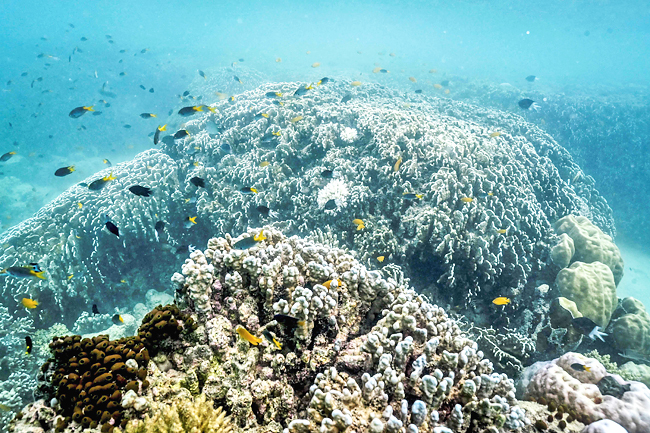LIZARD ISLAND (AFP) – Australia’s famed Great Barrier Reef is suffering one of the most severe coral bleaching events on record, leaving scientists fearful for its survival as the impact of climate change worsens.
For 33 years, marine biologist Anne Hoggett has lived and worked on Lizard Island, a small slice of tropical paradise off Australia’s northeast tip. She affectionally dubs it “Blizzard Island”. The only relief from the wind and teeming showers is in the powder blue waters, where sea turtles and tiger sharks rove along the Great Barrier Reef.
As Hoggett snorkels, schools of fish swim gracefully, feeding on the coral or darting between it. Some are as small as her little finger, others the colour of fire. But thanks to climate change, it is becoming a watery graveyard of bleached reef. “We don’t know yet if they’ve already sustained too much damage to recover or not,” said Hoggett.
The world is currently experiencing its second major coral bleaching event in 10 years, the United States National Oceanic and Atmospheric Administration (NOAA) announced. Coral bleaching occurs when water temperatures rise more than one degree Celsius (oC).
“As the world’s oceans continue to warm, coral bleaching is becoming more frequent and severe,” said NOAA’s Derek Manzello.
In a bid to survive, the coral expels microscopic algae, known as zooxanthellae, which it needs to live. If high temperatures persist, the coral eventually evicts most of the zooxanthellae turns white and dies.
Since February, ocean temperatures around Lizard Island have been up to 2oC warmer than the average. Hoggett estimates about 80 per cent of the coral is already dead.



Often dubbed the world’s largest living structure, the Great Barrier Reef is a 2,300-kilometre long expanse housing a stunning array of biodiversity, including more than 600 types of coral and 1,625 fish species. It is vital to the health of the ocean and Australia’s tourism industry, netting billions of dollars every year.
But repeated mass bleaching events have robbed the reef of its wonder, turning banks of once-vibrant corals to a sickly ashen white.
In March, Australian reef authorities announced another mass bleaching event was underway, the fifth in eight years. Through aerial monitoring, they found more than 600 reefs have experienced bleaching. Ten per cent of the area is classed as suffering extreme bleaching, when more than 90 per cent of corals are distressed and unlikely to survive. Just nine weeks ago, the reef off Lizard Island was healthy and vibrant, Hoggett said.
Now, she points to the fluorescent pink and blue coral. Despite its initial beauty, that means the coral is highly stressed and expelling the healthy algae it needs to survive. Elsewhere, white coral is covered in a fluffy, brown algae – a sign it is dead.
When Hoggett first arrived on the island three decades ago, bleaching would occur every 10 years or so. Now, it is happening every year. Mass bleaching events along the reef occurred in 1998, 2002, 2016, 2017, 2020, 2022 and now 2024. She is heartbroken.
“The only time we’ve seen bleaching this bad was in 2016, when just about everything died,” Hoggett told AFP. “It’s anybody’s guess as to how many of these corals that are still alive now will be able to survive and recover.” While reefs can recover from bleaching, the window of recovery between events is narrowing. As the planet continues to warm, bleaching is forecast to reduce global coral cover by 95 per cent if temperatures warm by about 2oC.
If the rise is up to 1.5oC above pre-industrial levels, bleaching will spread to 70 per cent.
Even if all countries deliver on their climate commitments, the world would still be on track for two degrees or more of warming.
Globally, billions of dollars are being poured into coral bleaching mitigation projects – including breeding coral on artificial reefs and translocating it, making clouds more heat reflective, or controlling coral predators. These site-specific conservation efforts are important, but Terry Hughes, one of Australia’s foremost coral reef scientists, said they do nothing to address the root cause of bleaching: climate change.
“After 50 years of interventions, coral restoration attempts have not changed the ecology of a single reef anywhere,” Hughes said. “They’re just too small in scale.”


